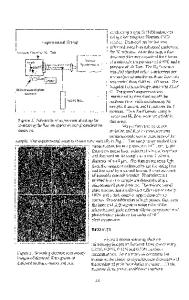Measurement of crystalline strain and orientation in diamond films grown by chemical vapor deposition
- PDF / 460,003 Bytes
- 5 Pages / 593.28 x 841.68 pts Page_size
- 117 Downloads / 410 Views
(Received 9 April 1990; accepted 27 June 1990) We have used x-ray diffraction to characterize diamond films grown in three characteristic morphologies by chemical vapor deposition. Each morphology has a fiber texture about the growth direction; we report the crystal axis aligned in this direction for each morphology. In all cases the average lattice constant agrees with that of bulk diamond; we report the range of strain in each sample.
I. INTRODUCTION
The formation of diamond films by several techniques of chemical vapor deposition (CVD) holds great promise for producing cutting tools, protective coatings, and electronic devices. While a monocrystalline film is ideal for many applications, progress in this area has been largely limited to monocrystalline deposits on diamond substrates, greatly restricting practical applications. Polycrystalline films have been produced with three distinct growth morphologies.1"12 A detailed crystallographic study of the three basic morphologies grown by a single process on a particular substrate was undertaken to provide information which may be generally applicable to CVD growth of diamond. The morphology was controlled by varying substrate temperature; conditions were otherwise identical. These three growth morphologies have been distinguished by the facets visible by optical and scanning electron microscopy. The first has been referred to910 as a {111} morphology due to prominent triangular {111} facets, but since the crystal habit is one of twinned cubo-octahedra,1"4'612 we will refer to it more descriptively as the pyramidal morphology. What we will call the square morphology is characterized by square {100} facets, the microcrystalline morphology by a grain size below 0.2 jam, and by the absence of faceting. While the crystal habits have been well characterized, few observations have been made of the crystalline orientation of the film relative to the substrate. A sample of pyramidal morphology was determined to have a fiber texture, with the (110) direction parallel to the specimen surface normal.11 The grains have their (110) directions distributed randomly azimuthally, but the tilt of the (110) from the surface normal has a 15° full width half maximum (FWHM) distribution centered at zero. A small fraction of the sample is aligned with the (114) parallel to the surface normal, which is characteristic of twinning on {111} planes. Electron microscopy and diffraction measurements show that for samples with square morphology the (100) direction is roughly parallel to the surface normal with
a tilt of up to 30° (Ref. 9). We found no reports of the crystalline orientation for the microcrystalline morphology. In this paper we report x-ray diffraction measurements for diamond films, giving the orientation of all three morphologies and the strain profiles as well. II. EXPERIMENTAL
The film growth procedures have been detailed previously.12 Briefly, 1% methane in hydrogen flows at a rate of 55 std cc/min and a pressure of 40 Torr past a tungsten filament heated to 2000 °C. After
Data Loading...










